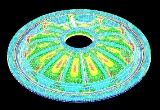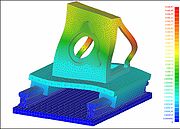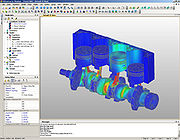
NEi Nastran
Encyclopedia

NEi Software
-Overview:NEi Software, founded as Noran Engineering, Inc. in 1991, is an engineering software company that develops, publishes and promotes FEA software programs including its flagship product NEi Nastran. The FEA algorithms allow engineers to analyze how a structure will behave under a variety...
(formerly known as Noran Engineering, Inc.) Based on NASA
NASA
The National Aeronautics and Space Administration is the agency of the United States government that is responsible for the nation's civilian space program and for aeronautics and aerospace research...
's Structural Analysis program, the software is a finite element analysis
Finite element method
The finite element method is a numerical technique for finding approximate solutions of partial differential equations as well as integral equations...
(FEA) solver used to generate solutions for linear and nonlinear stress, dynamics, and heat transfer characteristics of structures and mechanical components. NEi Nastran software is used with all major industry pre and post processors including Femap
Femap
Femap is an engineering analysis program sold by Siemens PLM Software that is used to build finite element models of complex engineering problems and view solution results...
, a product of Siemens PLM Software, in house brands NEi Fusion
NEi Fusion
NEi Fusion is a finite element analysis program sold by NEi Software that is used by engineers to build and analyze models of parts and assemblies of various products...
, and NEi Works for SolidWorks
SolidWorks
SolidWorks is a 3D mechanical CAD program that runs on Microsoft Windows and is being developed by Dassault Systèmes SolidWorks Corp., a subsidiary of Dassault Systèmes, S. A. . SolidWorks is currently used by over 1.3 million engineers and designers at more than 130,000 companies worldwide...
.
History
The original NASTRANNastran
NASTRAN is a finite element analysis program that was originally developed for NASA in the late 1960s under United States government funding for the Aerospace industry. The MacNeal-Schwendler Corporation was one of the principal and original developers of the public domain NASTRAN code...
program came out of NASA’s need to develop a common generic structural analysis program that would be used by all of the centers supporting the space program. A specification was written and a contract was awarded to Computer Sciences Corporation for development of NAsa STRuctural ANalysis (NASTRAN) software. NASTRAN was released to NASA in 1968. In addition to NEi Nastran, commercial versions of are also available from Siemens PLM Software (NX Nastran) and others
Nastran
NASTRAN is a finite element analysis program that was originally developed for NASA in the late 1960s under United States government funding for the Aerospace industry. The MacNeal-Schwendler Corporation was one of the principal and original developers of the public domain NASTRAN code...
.
Improvements
In the late 1960s, Finite Element Analysis software was confined to run on expensive mainframe computers and highly trained specialists were needed to apply the program. In this environment, the aerospace industry was the typical user because they had critical projects which could justify the resources FEA demanded. With improvements to the software and wider use of mainframes, FEA technology gradually spread to large corporations that could afford funding the huge investment in hardware, software, and a dedicated FEA staff. Usage spread from primarily aerospace and military applications to the automobile and maritime industries.The microprocessor revolution and the advent of Personal Computers (PCs) in the 1980s brought tremendous improvements in computing power, significant reductions in computing costs, and the steady development of numerical methods and algorithms. In the mid 1980’s, Noran Engineering recognized the long term advantages and impact that the PC hardware revolution could have on the engineering analysis field and embarked on a project to significantly enhance and modernize the original NASTRAN code and port it to PCs.
The first commercial version of NEi Nastran for use on PCs was released in 1990. The new code had a number of changes in architecture and programming language compared to legacy Nastran written originally for mainframes. These differences were intended to take advantage of the dramatic changes in computer hardware taking place and provide the code with key strategic advantages for the new PC platform. For example, since the cost of memory was dramatically reduced it was feasible to perform many operations faster in memory that normally were only done on disk.
Present day


